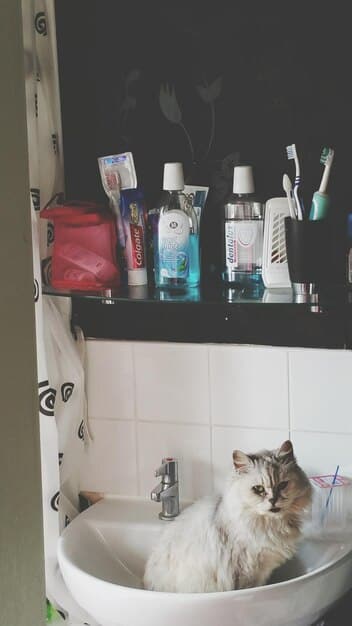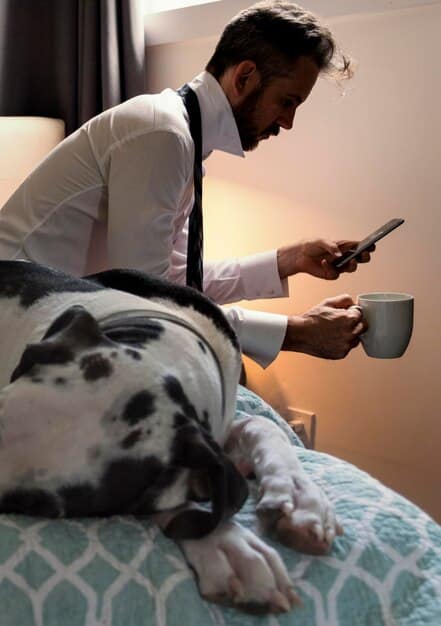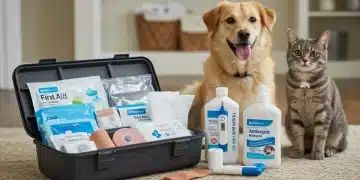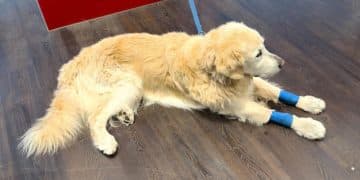Poison Prevention: Keep Your Pet Safe from Household Hazards

Poison prevention is crucial for pet safety, involving identifying and securing household hazards to prevent accidental ingestion and potential health risks.
As pet owners, we strive to create safe and loving environments for our furry companions. A critical aspect of pet care is poison prevention: identifying household hazards and protecting your pet from accidental ingestion.
Poison prevention: understanding the risks
Many common household items can pose a significant threat to our beloved pets. Understanding these risks is the first step in creating a safer home environment.
From everyday cleaning supplies to seemingly harmless medications, pets can accidentally ingest substances that lead to severe health consequences.
Common household toxins
Numerous substances found within our homes can be toxic to pets. These range from obvious dangers like pesticides to more unassuming items like certain foods.
- Medications: Both prescription and over-the-counter drugs intended for humans can be deadly to pets.
- Cleaning Supplies: Bleach, detergents, and disinfectants can cause severe burns and internal damage if ingested.
- Pesticides: Insecticides, rodenticides, and herbicides are designed to be toxic and can harm pets even in small amounts.
- Certain Foods: Chocolate, grapes, onions, and garlic are among the foods that are poisonous to animals.

Understanding these threats is essential for maintaining a pet-safe home. Awareness is key to prevention.
By being informed about common household toxins, pet owners can take proactive steps to prevent accidental ingestion and protect their animal companions.
Securing potential poisons in your home
Once you know what the hazards are, it’s time to take action. Properly storing and securing potential poisons is paramount importance to pet safety.
Making your home a fortress against accidental ingestion involves strategic placement and vigilant monitoring.
Safe storage practices
Implementing effective storage practices is fundamental to mitigating the risk of pet poisoning.
- Keep Medications Out of Reach: Store all medications, both human and animal, in secure cabinets or containers that pets cannot access.
- Lock Away Cleaning Supplies: Keep cleaning products in locked cabinets or high shelves, far from your pet’s reach.
- Properly Dispose of Toxins: Dispose of empty containers of cleaning products or pesticides immediately and safely.
- Secure Trash Cans: Use trash cans with secure lids to prevent pets from scavenging for discarded food or other potentially harmful items.
These measures can greatly reduce the likelihood of accidental ingestion and create a safer environment for your pets.
Consistent adherence to these storage practices is crucial for long-term poison prevention in your home.
Recognizing signs of poisoning in pets
Despite our best efforts, accidents can still happen. Recognizing the signs of poisoning in pets is crucial to facilitate prompt treatment.
Early detection can significantly improve the chances of a positive outcome.

Key symptoms to watch for
Familiarizing yourself with the common symptoms of poisoning will allow you to react expediently.
- Vomiting or Diarrhea: These are common signs of gastrointestinal distress and can indicate ingestion of a toxic substance.
- Lethargy or Weakness: A sudden decrease in energy levels or general weakness can signal that your pet’s system is compromised.
- Loss of Appetite: Loss of interest in food is a non-specific symptom that, in conjunction with other signs, may suggest poisoning.
- Seizures or Tremors: Neurological symptoms such as seizures or tremors are alarming signs that require instantaneous veterinary attention.
If you observe any of these signs, it is essential to seek immediate veterinary care.
Quickly reacting to these symptoms can save your pet’s life and alleviate potential long-term health damage.
First aid for pet poisoning
While immediate veterinary attention is crucial in cases of suspected poisoning, knowing basic first aid can stabilize your pet until you can get to a vet.
These steps are not a substitute for professional care but can buy valuable time.
Immediate steps to take
If you suspect your pet has ingested a poison, there are actions you can take before going to the veterinary hospital.
- Identify the Poison: If possible, identify the substance ingested. This information will be invaluable to your veterinarian.
- Contact Your Veterinarian or an Emergency Poison Hotline: Seek expert advice promptly. Do not attempt to treat your pet without professional guidance.
- Bring the Substance: If safe to do so, bring the toxic substance or its packaging with you to the vet.
By following these immediate steps, you can assist your vet in providing the best possible care for your pet.
Remember, never induce vomiting unless instructed to do so by a veterinarian or poison control expert, as some substances can cause more harm if regurgitated.
Preventive measures: creating a pet-safe environment
In addition to securing poisons, other preventive measures can further enhance your home’s safety for pets.
Creating a pet-safe environment involves a holistic approach to risk management.
Enhancing pet safety
Creating a safe environment for pets goes beyond merely locking away toxins; it involves several proactive steps.
- Educate Your Family: Ensure all family members and visitors are aware of the potential dangers to pets and follow safety protocols.
- Regularly Inspect Your Home: Conduct periodic inspections for potential hazards, such as loose wires, exposed chemicals, or accessible medications.
- Pet-Proof Your Yard: Secure your yard by removing poisonous plants, safely storing fertilizers and pesticides, and ensuring your pet cannot escape and ingest something harmful outdoors.
By taking these comprehensive measures, you can greatly mitigate the risk of accidental poisoning for your pet
A pet-safe home is a happy home, and these preventive steps can help provide peace of mind for you and increased safety for your furry friend.
Educating yourself on pet toxins
Knowledge is power when it comes to pet poison prevention. Educating yourself about potential toxins is an ongoing process.
Remaining informed about new threats and best practices is crucial for protecting your animal companion.
Resources for pet owners
Numerous resources are available to help pet owners stay informed and prepared regarding potential toxins.
Consult credible sources to enhance your understanding and preparedness.
- Veterinary Professionals: Your veterinarian is an invaluable resource for pet health and safety information.
- Pet Poison Hotlines: Pet poison control hotlines are available 24/7 to provide expert advice in case of suspected poisoning.
- Online Resources: Reliable online resources, such as veterinary websites, offer comprehensive information on pet toxins and preventive measures.
By staying informed and engaged, you can provide the best possible protection for your pet.
Remember, being a responsible pet owner means continually learning and adapting to ensure your pet’s well-being and safety.
| Key Point | Brief Description |
|---|---|
| ⚠️ Identify Hazards | Recognize common household items that are toxic to pets. |
| 🔒 Secure Poisons | Store medications, cleaning supplies, and toxins in locked or inaccessible areas. |
| 🚨 Recognize Symptoms | Be alert to signs of poisoning like vomiting, lethargy, or seizures. |
| 📞 Seek Help Fast | Contact a vet or pet poison hotline immediately if poisoning is suspected. |
FAQ
▼
Chocolate, onions, garlic, grapes, raisins, alcohol, and products containing xylitol are hazardous foods for pets and should be completely avoided to prevent toxicity.
▼
Store all medications in secured, pet-proof containers or cabinets that are completely out of reach. Make sure lids are tightly closed to prevent accidental ingestion.
▼
Immediately contact your veterinarian or a pet poison control center. Provide details about the substance ingested, and follow their instructions closely to assist appropriately.
▼
Yes, cleaning products such as bleach, detergents, and disinfectants can be very toxic. Always store them in locked cabinets, and use them carefully in areas pets cannot access.
▼
Remove poisonous plants, safely store garden products like fertilizers and pesticides, and ensure your pet cannot escape and ingest harmful substances outdoors. Regular checks are important.
Conclusion
Protecting your pet from accidental poisoning requires a proactive and informed approach. By identifying household hazards, securing potential toxins, and recognizing signs of poisoning, you can create a safer environment for your animal companion and ensure their well-being.





